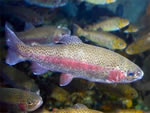 If you love fish, there’s nothing better than a fresh fish dinner while camping. That’s what makes fishing a popular activity along this area of the Mokelumne River. Do you fish here and have a fish story to tell or a photo to share? Do you have tips on how to fish this area and what bait/lure you prefer? If there’s anything you would like to add to this article, please comment below or leave us some feedback!
If you love fish, there’s nothing better than a fresh fish dinner while camping. That’s what makes fishing a popular activity along this area of the Mokelumne River. Do you fish here and have a fish story to tell or a photo to share? Do you have tips on how to fish this area and what bait/lure you prefer? If there’s anything you would like to add to this article, please comment below or leave us some feedback!
What and Where
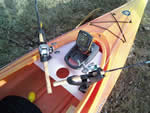 Rainbow, brook and brown trout are species known to roam these waters. The three campgrounds, Mokelumne, Moore Creek and White Azalea, are located along the river with access for fishing. Also, Devil’s Nose Day Area has easy river access for fishing. There is also fishing from Salt Springs Reservoir, either by boat or from the banks. The Forest Service website states, “Car top boat launching available at Salt Springs Reservoir. Access to the water is difficult. Boating is hazardous when windy (usually in the afternoons)“. Kayaks are gaining in popularity due to their light weight, ease of transport and low draft. NorCal Kayak Anglers has some good tips on trolling for trout in a kayak.
Rainbow, brook and brown trout are species known to roam these waters. The three campgrounds, Mokelumne, Moore Creek and White Azalea, are located along the river with access for fishing. Also, Devil’s Nose Day Area has easy river access for fishing. There is also fishing from Salt Springs Reservoir, either by boat or from the banks. The Forest Service website states, “Car top boat launching available at Salt Springs Reservoir. Access to the water is difficult. Boating is hazardous when windy (usually in the afternoons)“. Kayaks are gaining in popularity due to their light weight, ease of transport and low draft. NorCal Kayak Anglers has some good tips on trolling for trout in a kayak.
When
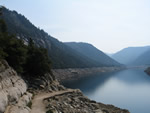 The Salt Springs Dam, the campgrounds and Devil’s Nose Day Area are open year-round, however, only one road is maintained during winter (November-February). Tiger Creek Road is maintained by PG&E year round. The turnoff is located on the right off Highway 88 (going east) at Sierra Trading Post, about 17.5 miles from Jackson, CA. The main access, Ellis Road, does not generally open until May, depending on snowfall. It stays open until November, again, depending on the weather. The ideal water temperature for trout, according to Fishing Tips Depot, is between 50-60 degrees F.
The Salt Springs Dam, the campgrounds and Devil’s Nose Day Area are open year-round, however, only one road is maintained during winter (November-February). Tiger Creek Road is maintained by PG&E year round. The turnoff is located on the right off Highway 88 (going east) at Sierra Trading Post, about 17.5 miles from Jackson, CA. The main access, Ellis Road, does not generally open until May, depending on snowfall. It stays open until November, again, depending on the weather. The ideal water temperature for trout, according to Fishing Tips Depot, is between 50-60 degrees F.
Live Bait
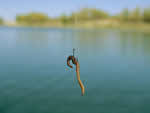 According to the National Wildlife Association, trout will eat just about anything: fish eggs, small fish, crustaceans, mollusks, insects and even mice. Speaking with anglers fishing along the river, nightcrawlers (earthworms) are a preferred live bait.
According to the National Wildlife Association, trout will eat just about anything: fish eggs, small fish, crustaceans, mollusks, insects and even mice. Speaking with anglers fishing along the river, nightcrawlers (earthworms) are a preferred live bait.
Synthetic Bait
Fishing Tips Depot is emphatic that, “Power Bait ONLY Works on Stocked Trout”, since stocked fish will eat anything that resembles the hatchery pellets on which they were raised. Powerbait is a brand-name for synthetic trout bait.
Lures
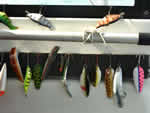 Spoons and spinners seem to be favorites for trout fishing. Since trout also like small fish and crustaceans, minnow and crawfish lures are popular. According to How To Catch Any Fish, rainbow trout can turn off to one lure and on to another lure with no warning. Therefore, it’s not a bad idea to carry a variety of lures. Fishing Tips Depot gives pretty good information on the best trout lures.
Spoons and spinners seem to be favorites for trout fishing. Since trout also like small fish and crustaceans, minnow and crawfish lures are popular. According to How To Catch Any Fish, rainbow trout can turn off to one lure and on to another lure with no warning. Therefore, it’s not a bad idea to carry a variety of lures. Fishing Tips Depot gives pretty good information on the best trout lures.
Flies
Dry flies, wet flies, nymphs. What to use? Fly Fishing Discounters states that you have to, “match the hatch”, or use the equivalent of whatever real flies are currently out there in the area you’re fishing. The three main types of flies, as described by The Fly Fishing Basics, are the dry fly, nymphs, and streamers. How to fly fish? There are plenty of videos out there but after you master the basics, it’s like anything: practice, practice, practice.
Rod & Reel
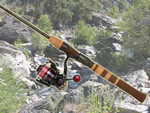 Because the Mokelumne River is considered to be small in this area, a light (or ultra light) rod and reel is recommended by How Stuff Works. An ultra light rod of 4-5 feet is useful when you’re surrounded by trees and bushes, which inhibits casting, as is frequently encountered here. A 2-4 lb line is also recommended by How Stuff Works because the lighter the line, the less obvious to the trout. Whether you use a spin cast (closed faced) reel, an open face spinning reel or a bait casting reel depends on your preferences. However, How To Catch Any Fish recommends a spinning reel for trout. About Rods and Reels gives an excellent explanation of these three types of reels.
Because the Mokelumne River is considered to be small in this area, a light (or ultra light) rod and reel is recommended by How Stuff Works. An ultra light rod of 4-5 feet is useful when you’re surrounded by trees and bushes, which inhibits casting, as is frequently encountered here. A 2-4 lb line is also recommended by How Stuff Works because the lighter the line, the less obvious to the trout. Whether you use a spin cast (closed faced) reel, an open face spinning reel or a bait casting reel depends on your preferences. However, How To Catch Any Fish recommends a spinning reel for trout. About Rods and Reels gives an excellent explanation of these three types of reels.
Additional Resources
There are regulations to respect and licenses to buy in order to fish the Mokelumne River. As the California Department of Fish and Wildlife states on its website, “a sport fishing license is required for any person attempting to take fish, mollusks, crustaceans, invertebrates, amphibians, or reptiles in inland or ocean waters. Additional validations and report cards are required for certain species and areas”. In California, the fine for Failure to Show License, Equipment, or Game is $100. The fine for Unlawful Taking or Possessing of Fish or Wildlife is $200. A Resident Sport Fishing license for any resident 16 years of age or older costs $47.01 for the season valid January 1, 2015 through December 31, 2015.
- Regulations
- License Fees
- Online Licences
- Fines (page 118)
Status
Ellis Road: Open
Area Status: Open
Updated: 8/18/2015